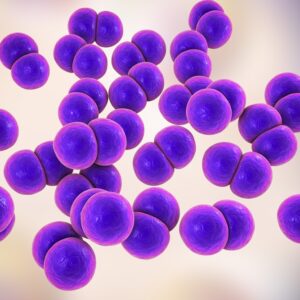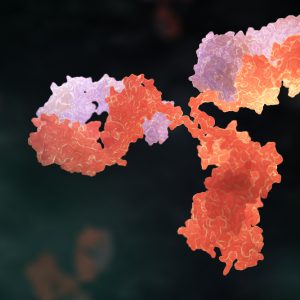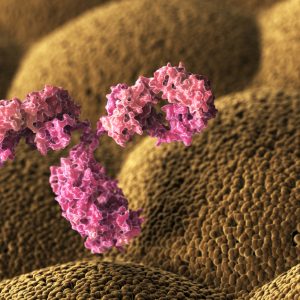Streptococcus
Streptococcus is a genus of gram-positive cocci bacteria, which occurs in twisted chains or pairs. Many Streptococcus species are commensals of the human skin, mouth, intestine, or respiratory tract, some are used in the food industry. Although several Streptococcus species are known human pathogens causing skin infections, pharyngitis, or even scarlet fewer outbreaks.
The Native Antigen Company are committed to supporting research into Streptococcus, offering antigens and antibodies for the most clinically relevant Streptococcal species such as S.pneumoniae, S.agalactiae, S.pyogenes.
Streptococcus Background
Streptococcus pneumoniae is a lancet-shaped, gram-positive, facultative anaerobic bacterium. In humans, S. pneumoniae primarily colonizes the nasopharynx and transmission occurs from person-to-person via respiratory secretions from patients infected wit, S. pneumoniae, and from healthy carriers. In susceptible individuals, the bacteria can spread to the lower respiratory tract, the inner ear or sinuses, to cause a range of illnesses, referred to as pneumococcal disease.
Worldwide, S. pneumoniae is the major cause of pneumonia, sepsis, and meningitis and the leading cause of community-acquired pneumonia in young children and the elderly.
Streptococcus agalactiae (also known as group B streptococcus or GBS) is a gram-positive coccus (round bacterium) with a tendency to form chains (as reflected by the genus name Streptococcus). It is a beta-hemolytic, catalase-negative, and facultative anaerobe. It is surrounded by a bacterial capsule composed of polysaccharides (exopolysacharide). The species is subclassified into ten serotypes (Ia, Ib, II–IX) depending on the immunologic reactivity of their polysaccharide capsule. GBS is a harmless commensal bacterium being part of the human microbiota colonizing the gastrointestinal and genitourinary tract of up to 30% of healthy human adults (asymptomatic carriers). Nevertheless, GBS can cause severe invasive infections especially in newborns, the elderly, and people with compromised immune systems. S. agalactiae is also a common veterinary pathogen, because it can cause bovine mastitis (inflammation of the udder) in dairy cows and is an important source of economic loss for the industry. GBS in cows can either produce an acute febrile disease or a subacute more chronic condition. Both lead to diminishing milk production (hence its name: agalactiae meaning ‘of no milk’) (Edwards & Baker, 2010).
Streptococcus pyogenes (group A beta-hemolytic streptococcus; GAS) is a Gram-positive, catalase-negative cocci which can be carried asymptomatically. Streptococcus pyogenes is a bacterium which can colonise the throat, skin and anogenital tract and can cause both noninvasive and invasive disease, as well as nonsuppurative sequelae. It causes a diverse range of skin, soft tissue and respiratory tract infections including some life-threatening infections e.g. scarlet fever, bacteremia, pneumonia, necrotizing fasciitis, myonecrosis and Streptococcal Toxic Shock Syndrome (StrepTSS). Each year, the bacterium affects 700 million people globally, leading to 160,000 deaths. Streptococcal disease is ordinarily spread by direct person-to-person contact. In cases of pharyngitis and respiratory infections, droplet nuclei of saliva or nasal secretions are the mode of spread. Crowding such as occurs in schools or military barracks favors interpersonal spread of the organism in community outbreaks. Fomites can also be a source of streptococcal transmission (Chowdhury et al., 2021)
REFERENCES
- Chowdhury S, Khakzad H, Bergdahl GE, Lood R, Ekstrom S, Linke D, Malmström L, Happonen L, Malmström J. Streptococcus pyogenes Forms Serotype- and Local Environment-Dependent Interspecies Protein Complexes. mSystems. 2021 Sep 28:e0027121. doi: 10.1128/mSystems.00271-21. Epub ahead of print. PMID: 34581598.
- Edwards MS, Baker CJ (2010). “Streptococcus agalactiae (group B streptococcus)”. In Mandell GL, Bennett JE, Dolin R (eds.). Principles and practice of infectious diseases (7th. ed.). Elsevier. pp. Cap. 202.
- Keefe GP. Streptococcus agalactiae mastitis: a review. Can Vet J. 1997;38(7):429-437.
- Whiley RA, Hardie JM (2009). Genus I. Streptococcus Rosenbach 1884. Bergey’s Manual of Systematic Bacteriology: Vol 3: The Firmicutes (2nd ed.). Springer. pp. 655–711
Streptococcus Antigens
The Native Antigen Company are pleased to offer Streptococcus native lysates for use in the development of immunoassays.
Streptococcus Antibodies
The Native Antigen Company are pleased to offer Streptococcus antibodies, suitable for use in the development of immunoassays.
Questions?
Check out our FAQ section for answers to the most frequently asked questions about our website and company.



